In collaboration with the Iowa State Hygienic Laboratory (SHL) development team, the newborn screening (NBS) and Short-term Follow-up (STFU) module is now available in OpenELIS. This milestone is the beginning of a more efficient, data-driven, and collaborative approach to newborn health screening.
The Iowa SHL development team has been working towards building a configurable modular approach to Newborn Screening in OpenELIS that enables each lab to customize the module to their needs and support their current process. This module carries the same familiar, easy-to-use screens and simple client-defined workflows that labs need, with advanced features designed to support the high-volume, time-sensitive world of Newborn Screening. Read about the OpenELIS Foundation's attendance at the 2024 APHL Newborn Screening Symposium here.
Sample Intake and Accessioning Using Logic-driven Screens
Lab staff can easily begin the sample intake process by using the Quick Entry screen to assign an accession number and the required newborn screening tests to each specimen. OpenELIS features printable, scannable labels specifically designed for multi-part Newborn sample collection cards. This quick and easy process of assigning accession numbers and tests to newborn specimens allows lab staff in the NBS lab to quickly begin the time-critical testing.
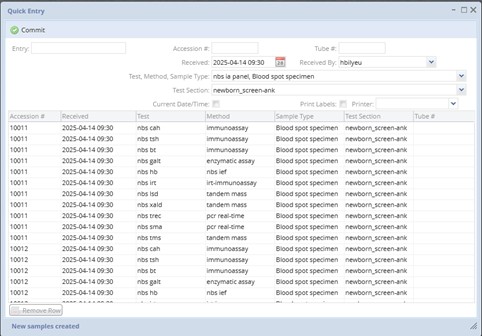
While lab staff perform the required testing, data entry staff use the intelligent Newborn Sample Login screen to enter all demographic information provided with each specimen. Sample login can be completed manually or through pulling in electronic orders. This screen features automatic calculations for critical fields, such as collection age and transfusion age, that support accurate result interpretation and help identify potential result interference. These and other key fields can trigger automatic quality assurance events, which are logged and tracked for each specimen based on client-defined processes.
Dropdown menus are customizable at any time to meet specific client needs. Key identifiers are used to detect if a specimen has previously been received for the same baby and will automatically flag the sample as a repeat when applicable. The Newborn Sample Login screen shares the same look and feel as all other sample login screens in OpenELIS, so for current OpenELIS clients, data entry training is minimal.
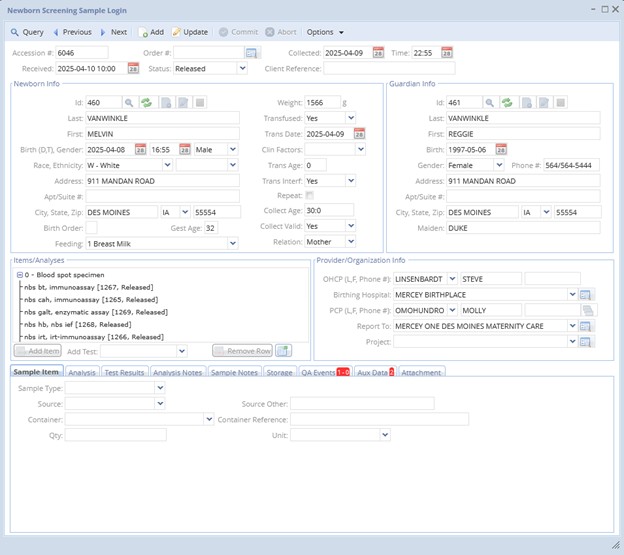
Automatically Translating Screening Data into Clinically Relevant Results
The OpenELIS Newborn Screening Module is specifically designed to support both speed and high-volume testing. Users create worksheets in the system per test and worksheets are populated with result data through instrument interfacing. Each test is powered by a specialized piece of code, known as a scriptlet, which interprets numeric results into meaningful screening outcomes by reviewing demographic information along with analyte parameters configured by a LIMS administrator. The LIMS Administrator can configure any newborn test with a result that falls outside of normal limits to be automatically placed into a requeue status, allowing lab staff to further investigate or retest the sample.
Once results are reviewed, finalized and released OpenELIS can be configured to automatically generate result reports, which will be dispatched to relevant stakeholders like primary care providers, birthing hospitals or secondary recipients where required. Flagged cases will then move into the integrated Newborn Follow-up Module.
Supporting Early Intervention for Every Newborn with an Integrated and Streamlined Short-Term Follow-Up Module
The Newborn Follow-up or Short-term Follow-up (STFU) module is built to track vital screening and follow-up care in the first six months of life. The module resembles a project management tool but for newborn screening follow-up staff. It is designed to easily identify tasks (cases) and where they are in the process.
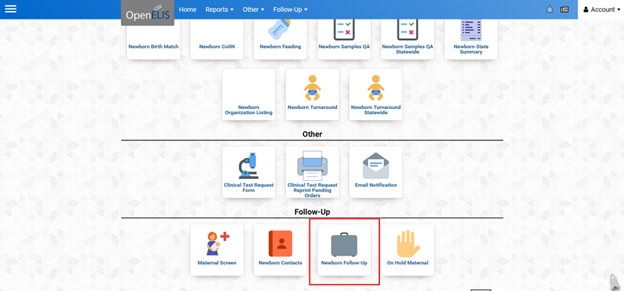
Because the newborn module is built on the same structure as other OpenELIS modules,
current OpenELIS client labs can adopt and configure it to their needs. The STFU module
enables newborn follow-up staff to:
- Review cases that display color-coded case tags which indicate urgency and required
timeframe for follow-up. - Customize tags and filters based on their processes and procedures
- Take ownership of cases and view them in a separate tab.
- Pull case history logs, with all sample activity.
- Customize and document notifications for cases that require follow-up work.
- Easily document and Organize: Recommendation letters, genetic counseling referrals,
confirmatory test results, family contact logs
Furthermore, one of the biggest impacts of this module is eliminating the manual process often used in newborn follow-up. Now, everything is centralized with:
- Configurable automated reminders
- Integrated confirmatory test tracking
- Searchable closed cases by multiple parameters
- Patient lookup across all associated records.
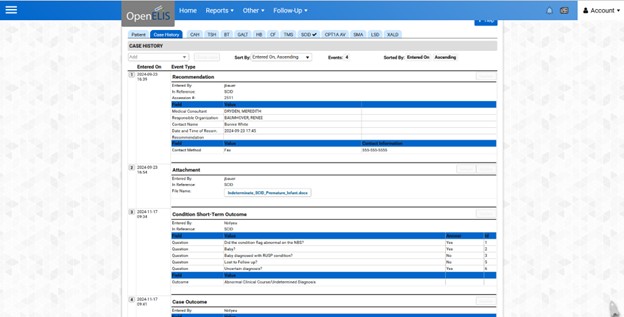
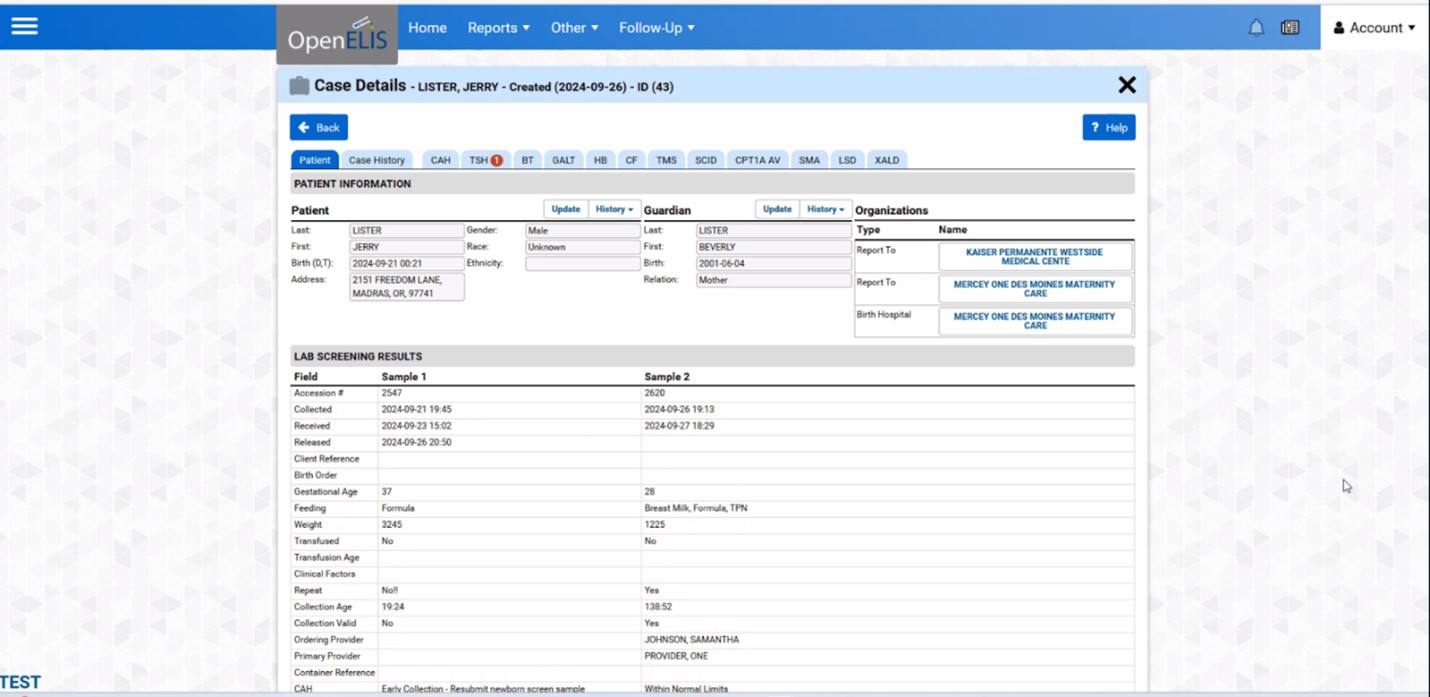
It’s not just about test results; it’s about ensuring that young lives have access to life-saving
newborn screening in the early days of their lives and this STFU module enables follow-up staff
to make that possible.
Final Thoughts
OpenELIS is proud to support early intervention with a LIMS solution that’s robust, configurable,
and easy to use. Contact us for more details on our newborn screening module.

